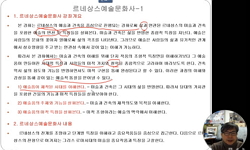석조문화재는 ‘석재’로 만들어진 문화재로 조성 목적에 따라서 여러 형태를 빌리고 있다. 그 중에서 석탑(승탑 포함)과 석불(마애불 포함)이 가장 많으며 문화사적 및 과학기술적 측면에...
http://chineseinput.net/에서 pinyin(병음)방식으로 중국어를 변환할 수 있습니다.
변환된 중국어를 복사하여 사용하시면 됩니다.
- 中文 을 입력하시려면 zhongwen을 입력하시고 space를누르시면됩니다.
- 北京 을 입력하시려면 beijing을 입력하시고 space를 누르시면 됩니다.
부가정보
국문 초록 (Abstract)
석조문화재는 ‘석재’로 만들어진 문화재로 조성 목적에 따라서 여러 형태를 빌리고 있다. 그 중에서 석탑(승탑 포함)과 석불(마애불 포함)이 가장 많으며 문화사적 및 과학기술적 측면에서 가장 중요하다고 판단된다. 문화사적인 것과 과학기술적인 특징은 왜? = why? 그리고 어떻게? = how?의 관계로 나타낼 수 있다. 전자는 이유, 원인 등으로 철학적인 면을, 그리고 후자는 방법론적인 면을 의미한다. ‘왜?’ 그들은 석탑과 석불을 제작하였으며 ‘어떻게’ 그것들을 조성할 수 있었을까? 이와 같이, 석조문화재는 대부분 (1) 정치-사회적, (2) 종교적, 그리고 (3) 문화사적 배경에 따라 형태적 측면의 영향을 받는다. 그러므로 문화재가 조성된 배경을 종합적으로 조사 및 분석하여 석조문화재 보존처리를 위한 원칙과 방법론에 대해 기술하고자 한다.
다국어 초록 (Multilingual Abstract)
The forms of stone cultural properties vary depending on the purpose of construction. In general, pagodas and statues of the Buddha (including the Maebul) are representative of stone cultural properties and demonstrate important aspects of cultural hi...
The forms of stone cultural properties vary depending on the purpose of construction. In general, pagodas and statues of the Buddha (including the Maebul) are representative of stone cultural properties and demonstrate important aspects of cultural history and scientific technology. The purpose for which cultural properties were constructed may influence construction technologies, so we must carefully think about and clearly understand the purpose of construction, namely the cultural and/or philosophical history, when conducting conservation treatments now. This may be examined through the relationship between “why?” and “how?”: Why did the builders construct these stone cultural properties, and how did they use such technologies? We may be deeply impressed by the form and delicacy of the sculpture, which is the “how” aspect of the technologies, but we must also understand the effect of the “why.” namely the soul and/or spirit of those who created the properties. The form of stone cultural properties may be influenced by (1) the political-social sphere, (2) religion, or (3) the cultural history of the period, which have changed over time. It is important that this is the view taken in current conservation treatment.
목차 (Table of Contents)
- 초록
- ABSTRACT
- 1. 머릿말
- 2. “왜?”와 “어떻게?”의 상호관계
- 3. 석조문화재의 철학적 면과 과학기술적 면과의 상호관계
- 초록
- ABSTRACT
- 1. 머릿말
- 2. “왜?”와 “어떻게?”의 상호관계
- 3. 석조문화재의 철학적 면과 과학기술적 면과의 상호관계
- 4. 문화재의 가치에 대하여
- 4.1. 절대적 가치 = 존재
- 4.2. 상대적 가치 = 실존
- 5. 석조문화재의 보존에 대한 일반론
- 6. 석탑과 석불의 조성상의 특징
- 6.1. 문화사적 특징
- 6.2. 형태상의 특징
- 7. 보존의 방법론에 대한 고찰
- 8. 보존에 있어서 철학적 문제
- 9. 결론
- REFERENCES
참고문헌 (Reference)
1 Lee, T.H., "The rock-cut Buddhist sculpture of the Korea" Ddworld 2002
2 Cho, J.H., "Ranke&Carr: In search of historical truth" Gimmyoung 2006
3 The Korean Society of Conservation Science for Cultural Heritage, "Conservation science terminology"
4 Lee, S.H., "A study on the preservation policy of stone cultural properties" 1998
5 Lee, S.H., "A study on establishment of basic concept for the conservation of stone cultural heritage" 2000
6 Ko, Y.S., "A study of Buddhist pagodas" Eulyoo Publishing Co., Ltd. 1947
1 Lee, T.H., "The rock-cut Buddhist sculpture of the Korea" Ddworld 2002
2 Cho, J.H., "Ranke&Carr: In search of historical truth" Gimmyoung 2006
3 The Korean Society of Conservation Science for Cultural Heritage, "Conservation science terminology"
4 Lee, S.H., "A study on the preservation policy of stone cultural properties" 1998
5 Lee, S.H., "A study on establishment of basic concept for the conservation of stone cultural heritage" 2000
6 Ko, Y.S., "A study of Buddhist pagodas" Eulyoo Publishing Co., Ltd. 1947
동일학술지(권/호) 다른 논문
-
- 한국문화재보존과학회
- 강산하
- 2018
- KCI등재
-
- 한국문화재보존과학회
- 이수정
- 2018
- KCI등재
-
천연 보강 매제의 종류 및 농도에 따른 토벽화 마감층 제작특성 연구
- 한국문화재보존과학회
- 문혜영
- 2018
- KCI등재
-
- 한국문화재보존과학회
- 이준호
- 2018
- KCI등재
분석정보
인용정보 인용지수 설명보기
학술지 이력
| 연월일 | 이력구분 | 이력상세 | 등재구분 |
|---|---|---|---|
| 2026 | 평가예정 | 재인증평가 신청대상 (재인증) | |
| 2020-01-01 | 평가 | 등재학술지 유지 (재인증) |  |
| 2017-01-01 | 평가 | 등재학술지 유지 (계속평가) |  |
| 2013-01-01 | 평가 | 등재학술지 유지 (등재유지) |  |
| 2010-01-01 | 평가 | 등재학술지 선정 (등재후보2차) |  |
| 2009-01-01 | 평가 | 등재후보 1차 PASS (등재후보1차) |  |
| 2007-01-01 | 평가 | 등재후보학술지 선정 (신규평가) |  |
학술지 인용정보
| 기준연도 | WOS-KCI 통합IF(2년) | KCIF(2년) | KCIF(3년) |
|---|---|---|---|
| 2016 | 0.52 | 0.52 | 0.47 |
| KCIF(4년) | KCIF(5년) | 중심성지수(3년) | 즉시성지수 |
| 0.5 | 0.47 | 0.455 | 0.1 |





 ScienceON
ScienceON eArticle
eArticle






